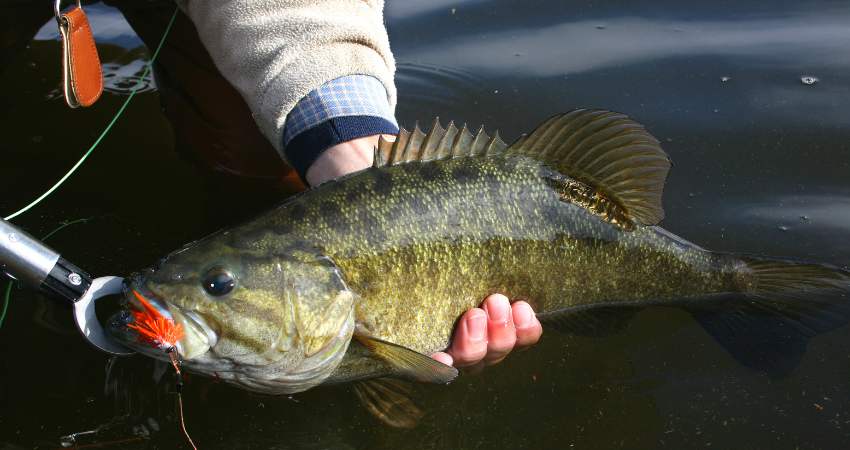Spotted Bass vs Smallmouth Bass: What’s The Difference?
Spotted bass and smallmouth bass have many similarities. For this reason many people ask about their differences. Let’s answer the question, what is the difference between spotted bass and smallmouth bass?
Spotted bass and smallmouth bass are different bass species although they are from the same family. Spotted bass prefer warm, clear, open waters and smallmouth bass prefer colder water. Spotted bass are commonly found more south in the Gulf states while smallmouth can be found as far north as Canada.
This article will compare the two bass species tastes, textures, cooking methods, costs, mercury levels and whether one can substitute for the other in recipes. In addition, I’ll do a side-by-side comparison of their habitats, size, weight and discuss their nutritional benefits.
Spotted Bass vs Smallmouth Bass: Habitats, Size, Weight, Appearance?
How can you tell the difference?
The easiest way to tell the difference between a spotted bass and smallmouth bass is by their body markings and dorsal fins. Spotted bass have black spots forming a jagged horizontal line dow their body. Smallmouth have brown vertical bars on their sides. Spotted bass dorsal fins are less separated.
Another easy way to tell the difference is their scales. The head scales on a spotted bass are smaller than the remaining part of the body. Smallmouth bass scales are uniform on the head and body.
Another way to tell the difference is by examine their tongue. Spotted bass have a rectangular tooth patch at the center of the tongue while smallmouths have a round patch of teeth.
Scientific Classifications, Families, Species
Spotted bass are from:
- Family: Centrarchidae
- Genus: Micropterus
- Species: M. punctulatus
- Common nicknames: Spotty, spots.
Smallmouth bass are from:
- Family: Centrarchidae
- Genus: Micropterus
- Species: M. dolomieu
- Common nicknames: Brown bass, brownie, small, bronze bass and bronze back.
Spotted and Small Habitats
Spotted Bass
- Native to the Mississippi River and across the Gulf states from Texas to Florida. In addition, they are found in the western Mid-Atlantic states. They have been introduced to Virginia, North Carolina and southern Africa.
- They prefer warmer waters with strong currents and turbulence.
- They prefer clear, open waters.
- When fishing they can be found in reservoirs and streams.
- Their nests are similar to those of the smallmouth.
Smallmouth Bass
- Native to the upper and middle Mississippi River Basin, the Great Lakes, Saint Lawrence River and the Hudson Bay Basin in Canada. They have been introduced into many cool-water rivers and lakes in the United States and Canada.
- They prefer colder waters.
Colors
- Spotted bass have a greenish gray body. They have dark, black spots forming a jagged horizontal line down the body.
- Smallmouth have a golden olive to brownish body. They have brown vertical bars or thick stripes down the body. The head has dark brown horizontal bars.
In open waters the smallmouth bass have a lighter color compared to a darker color when found in darker rivers.
Appearance
Dorsal Fin and Anal Fins
- Spotted bass has two dorsal fins clearly connected to each other.
- Smallmouth have two dorsal fins separated by a shallow notch. The front dorsal is shorter with spine rays. The second dorsal is taller with soft rays.
Mouth
- The spotted bass jaw does not extend past the eye line.
- The smallmouth bass protruding jaw doesn’t extend past the red or brown eyes.
Scales
- The scales on the spotted bass head are smaller than the ones on the remaining part of the body.
- The scales on a smallmouth bass are uniform across the body and head.
Tongue
- The spotted bass tongue has a course rectangular tooth patch at the center.
- The smallmouth bass can have a round patch of teeth on the tongue.
Bass Size and Weight
A smallmouth bass is bigger than a spotted bass. The average smallmouth bass is 12-16 inches long and the spotted bass 8-15″ long. A smallmouth bass weighs up to 10 pounds. A spotted bass weighs 1-2 pounds.
Age
- Spotted bass average lifespans is 7 years.
- Smallmouth bass oldest reported age is 26 years.
Spotted bass tend to live shorter lifespans than smallmouth.
Diet
Smallmouth bass and spotted consume the following:
- Copepods
- Crustaceans
- Insects
- Crayfish
- Other smaller fish
- Plankton
Fishing Tips and Fishing Tackle
Fishing Tips
Bass fishing requires dedication, perseverance and of course some luck. Largemouth are most anglers target when fishing.
River fishing for smallies can result in a good fishing day. Spotted bass are more aggressive. Spots are faster swimmers and fight a long time. For fishing tackle use the same size lures and plastics as largies.
In New York, you can go bass fishing June to November with a 12″ minimum and a daily limit of 5. From December to June, bass fishing is catch and release only. Check your local State for rules and regulations and look out for the game warden.
Find out how trout compared in my recent article, Trout – What’s The Difference? Let’s Compare.
Spotted Bass and Smallmouth Bass: Tastes and Textures
One of the most important things people takes into consideration when choosing a fish or fishing is its taste. When comparing the two fish, spotted bass vs smallmouth bass, let’s examine their tastes.
Spotted bass taste similar to smallmouth bass. They both have a mild to sweet, clean flavor. Both of them don’t have a fishy taste like the largemouth bass has. Their textures are both firm and their flesh are white.
Spotted bass has a mild to sweet taste. It is only slightly fishy but not overly strong. It’s much less fishier than a largemouth bass. The flesh is white and has a firm texture.
Smallmouth’s taste is mild to sweet. It is only slightly fishy but not enough to turn people away who don’t prefer a fishy taste. The flesh is white and has a firm texture.
I conducted original research for taste by polling my clients, members of food groups and readers. I asked them which fish tastes better?
- 54% said they preferred smallmouth.
- 46% said they preferred spotted.
To conduct more research on taste, I set up a blind taste test at home. Both fish were cooked and seasoned the same way. Out of four people the vote for the better taste was 50/50, similar to the poll.
How about them compared to largemouth bass? Find out in my recent article, Largemouth Bass: What’s The Difference?
Substitutions
When preparing recipes for dinner it’s not always possible to locate the type of fish in a store or while fishing. If you have only one species, you may wonder if you could substitute one for the other.
Spotted bass and smallmouth bass can substitute for each other due to their similar textures and tastes. They both have a firm texture and a mild to sweet taste. They both can be cooked using similar methods like grilling, baking, broiling and frying.
Smallmouth bass substitutes include the following:
- Freshwater trout
- Lake herring
- Mackerel
- Snapper
- Grouper
- Halibut
The best spotted bass substitutes are:
- Halibut
- Grouper
- Snapper
- Freshwater trout
- Lake herring
- Mackerel
Since both bass have similar tastes and textures their substitutes are similar. When substituting either bass always stick to the following:
- Same size and weight.
- Stick with similar fillets, whole fillet or cross section.
- Stick with skinless or skin when the recipe calls for one.
- Texture is more important for certain cooking methods. Like using a firmer texture when grilling1.
Check out the differences with these two species, spotted and largemouth bass, in my article, Largemouth Bass: What’s The Difference?

Spotted Bass and Smallmouth Bass Nutrition
Both bass provide a wide variety of nutrients, vitamins and minerals. Below is the nutrients contained in 4 ounces.
| Nutrient | Freshwater bass (4 ounces, raw) |
| Calories | 129 |
| Fat | 4.2 g |
| Saturated fat | 0.9 g |
| Cholesterol | 77 mg |
| Protein | 21 g |
| Omega-3 | 0.77 g |
| B-6 | 0.1 mg |
| B-12 | 2.2 mcg |
| Thiamin | .08 mg |
| Riboflavin | .08 mg |
| B-5 | 0.8 mg |
| Niacin | 1.4 mg |
| Folate | 17.0 mcg |
| Iron | 1.6 mg |
| Potassium | 403 mg |
| Magnesium | 34 mg |
| Phosphorus | 226 mg |
| Calcium | 90.7 mg |
| Zinc | 0.7 mg |
| Selenium | 14.2 mcg |
Both of them provide a high percentage of omega-3 fatty acids, minerals and B vitamins. These nutrients are beneficial for maintaining health which you can read about in the next section of this article.
It’s difficult to duplicate the nutritional value of most fish. Even chicken breast can’t fully equal the benefits due to its lack of omega-3 fatty acids most fish provide.
If you’re wondering how white bass compared to striped bass check out my article, White Bass vs Striped Bass: The Key Differences.
Mercury Levels
The EPA and The FDA have issued warnings and suggestions regarding mercury levels in fish and how often they should be consumed4. This is especially important for young infants, developing children and pregnant women.
They established a list of best fish, good choices and ones to avoid based on their mercury levels.
Spotted and smallmouth bass have similar levels of mercury. They have both been listed on some states advisory warnings in regards to high levels of mercury.
Everyone, especially if you’re pregnant, breast feeding or have a young child, always check with a physician prior to eating new foods or changing your dietary habits.
These mercury warnings can change over time or affect only a particular area or state. For bass or any fish species, check with your local EPA and FDA for the current recommendations especially while fishing5.
Spotted Bass and Smallmouth Bass Health Benefits
Since both fish provide the same nutrients the benefits are similar. I’ll list each nutrient and explain how each one benefit you starting with omega-3 fatty acids.
Omega-3 Fatty Acids
There is 0.77 grams of omega-3 fatty acids per four ounces of raw freshwater bass. Omega-3 fatty acids help maintain artery health which helps keep the heart healthy.
The omega-3 fatty acids provided help with the following health benefits:
- Lower fat cells in the blood (triglycerides).
- Reduce inflammation.
- Reduce plaque build-up.
- Helps keep bad cholesterol low and increase good cholesterol.
- Helps maintain normal heart rhythms.

Potassium
There are 403 mg per four ounces of raw bass. Potassium helps the body get rid of excess sodium which helps reduce fluid build-up. These helps keep systolic and diastolic blood pressure lower ((American Heart Association: How Potassium Can Help Control High Blood Pressure)).
The more potassium you consume, the more sodium your body will lose. Consuming too much sodium or not enough potassium throws off the delicate balance the kidneys need to remove the excess water6.
According to Harvard Health, a number of studies have shown a connection between low potassium levels and increased blood pressure7.
Calcium
Both bass provide a good amount of calcium. Calcium is important for blood pressure and the heart.
Harvard Health reports calcium helps maintain blood pressure because it helps to control the relaxing and tightening of blood vessels8. Calcium also helps the following:
- Build and maintain strong bones.
- Muscles need calcium to function properly.
- Improve nerve function.
Magnesium
There are 34 mg of magnesium per four ounces provided by freshwater bass. Magnesium calms and relaxes the whole body including blood vessels. Magnesium has been shown to help improve sleep related problems like insomnia ((National Institutes of Health: Magnesium)).
Magnesium helps keep blood pressure levels balanced and stable. A recent study researched 22 studies and concluded magnesium supplementation decreased diastolic and systolic blood pressure9.
Magnesium in bass helps control muscle and nerve function, blood sugar and blood pressure. In the muscles and heart, magnesium competes with calcium to help the muscles relax after contracting.
When the body is low in magnesium, calcium can over stimulate the heart muscle’s cells causing a rapid or irregular heartbeat.
B Vitamins
The B vitamins provided by bass include B1 (thiamin), B2 (riboflavin), B3 (niacin), B9 (folate) B6, B12 and B5. B vitamins help support the following:
- Energy levels.
- Red blood cells.
- Cardiovascular disease.
- Digestion.
- Nerve function.
- Brain function.
Selenium
There are 14.2 mcg of selenium per four ounces. Selenium is a nutrient which doesn’t receive much press. I’m unsure why many don’t write about it more because studies10 show selenium may help to protect the following:
- Heart disease
- Thyroid
- The immune system
- Cognitive issues

Phosphorus
There are 226 mg of phosphorus per four ounces. It has been shown in scientific research to help with the following:
- Muscle recovery after exercise.
- Muscle contraction.
- Help the body store and manage energy.
- Help the kidneys remove waste.
- Promote healthy nerve conduction.
- Promote teeth and bone strength.
I did a side-by-side nutrient and benefit comparison between two species, sea bass and cod. Find out which was better in my article, Sea Bass vs Cod – Is One Better? Let’s Compare.
As a Certified Health Coach, many of my clients inquire about seafood. In addition to coaching clients about smallmouth and spotted bass, I’ve purchased, researched and consumed both fish for over 20 years.
If you have any questions about this article or other featured content, don’t hesitate to email and notify us. You can find an email on our contact page. We’ll do our best to reply as soon as possible.
Read Next – More Fish vs Fish Articles!
White Perch vs White Bass: Which Is Better?
Sea Bass vs Salmon: Which Is Better?
Farm Raised or Wild Caught Shrimp – Which Is Best?
Brook Trout vs Brown Trout – Let’s Compare The Differences
Anchovies vs Sardines – What’s The Difference? Let’s Compare
Alaska Pollock vs Atlantic Pollock: Which Is Better?
- Sea Grant North Carolina: Fish Flavors and Substitutions [↩]
- Nutrition Value: Fish, raw, mixed species, fresh water, bass [↩]
- NutritionData: Fish, bass, fresh water, mixed species, raw [↩]
- FDA: Advice about Eating Fish [↩]
- National Center for Biotechnology Information: Mercury accumulation in largemouth bass (Micropterus salmoides) in a Florida lake [↩]
- National Center for Biotechnology Information: The Effect of the Sodium to Potassium Ratio on Hypertension Prevalence: A Propensity Score Matching Approach [↩]
- Harvard Health: Potassium lowers blood pressure [↩]
- Harvard Health: Key minerals to help control blood pressure [↩]
- National Center for Biotechnology Information: Effect of magnesium supplementation on blood pressure: a meta-analysis [↩]
- National Institutes of Health: Selenium [↩]
